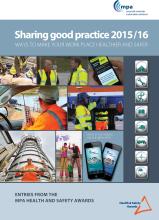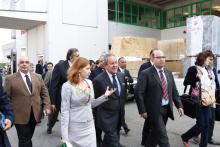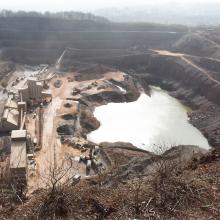The UK-based CPA (Construction Plant-Hire Association) Plant Conference 2014 attracted more than 140 attendees and a host of top level speakers.
CPA member and non-member delegates from hire companies, contractors, industry associations and government agencies were at the recent event in Wyboston Lakes in county Cambridgeshire, England to hear leading industry speakers discuss the ways in which those working within the UK construction plant hire sector can understand and influence the future of the industry.
Peter Hansford, Chief Construction Advisor to HM Government, provided delegates with an update on Construction 2025, the government’s vision for improvement within the built environment.
“Construction is important for the UK economy,” he said. “It provides £90bn (€114.16bn) per annum to the UK economy, around 7-8% of GDP and safeguards 3 million jobs, 10% of the workforce. The important message now, is that the Government gets this.”
Construction 2025 aims to show the way forward for construction over the next two decades. Initially announced in September 2012, and published in July 2013, Construction 2025 calls for: a 50% reduction in construction time; a 50% reduction in greenhouse gases; a 50% reduction in the trade gap between construction imports and exports; and a 33% drop in costs.
“This is not about reducing margins, but reducing waste, doing things more efficiently,” said Hansford. “This is about thinking and doing things very differently. That includes recognising the role that technology can and will play in the future. Technology is moving very fast and we will see a lot more site assembly of off-site manufactured components.”
Hansford called upon the industry to embrace diversity when looking for new employees. At present just 14% of construction workers are female, while only 2% come from ethnic minorities. He also outlined the need for an improvement in procurement methods, with greater cooperation and partnership required between suppliers, contractors and clients.
Philip White, the Health & Safety Executive’s Chief Inspector of Construction, pointed out how far construction has come in recent years. He said it was now 40 years since the Health & Safety At Work Act came into force and that the UK is now a world leader in health and safety.
“We have to work together, but construction has come a very long way in the last 15 years,” said White. “We want to continue that close working relationship that we have with the CPA and the Strategic Forum for Construction Plant Safety.”
Looking further ahead, White promised CPA members that they would see fewer inspections, but that they would be better targeted in future.
One of the safety areas that the CPA itself has been concentrating on is the assessment of ground conditions for lifting and excavating machinery. “No construction equipment is immune to ground conditions,” said Tim Watson, CPA Technical Consultant, at the 2014 Conference.
With ground condition safety in mind, the CPA is publishing a new guidance document ‘Ground Conditions for Construction Plant’ to assist site workers in choosing plant and assessing ground safety prior to positioning and lifting operations. The new guidance deals with ground bearing pressures and loadings from mobile plant and the assessment and engineering of the ground’s capability to withstand those loadings.
“If you are going to be using larger pads for instance, make sure that you know about the ground conditions further down,” said Mark Davies, Associate Director at RNP Associates. “If you are uncertain about the ground or the load you should increase the factor of safety.”
To help workers with this, the new document includes fairly simple methods for calculations on site, though Davies added that any calculation of risk should be carried out by employees at supervisor level.
The document can be downloaded for free from the CPA website from %$Linker:








